Coalbed Methane Extraction Using the Self-Oscillating Water Jet Slotting Method
Abstract
:1. Introduction
2. Characteristics of the Self-Oscillating Water Jet
2.1. Mechanism of SOWJ Generation and Its Characteristics
2.2. Rock-Breaking Characteristics of the SOWJ Impact
2.3. Cavitation Sonic Vibration Effect of the SOWJ
3. Slotting Effect of the SOWJ
3.1. Depressurising Effect of the Slotting
3.2. Formation of the Fracture Field of the Slots
4. Permeability-Increasing Mechanism of the SOWJ Slotting
4.1. Gas Flow Changes in the Slots
4.2. Changes of Coal Permeability
4.3. Gas Desorption Enhanced by the Vibration of the SOWJs
5. Field Experiment
5.1. Study Site Descroption
5.2. Experiment Design
Influence Range Test
5.3. Extraction Data Analysis
6. Conclusions
- (1)
- SOWJ slotting can be applied in high-efficiency CBM mining by concurrently increasing the fracture network, improving the permeability of the coal, and enhancing gas desorption.
- (2)
- The characteristics of the SOWJ were studied: by impacting on the coal-rock mass, SOWJ induces the formation of the erosion–peeling zone, fragmentation zone, and distal conical crack zone on the rock. The jet induces vibration of the coal mass at its own frequency and the simultaneous cavitation sonic vibrating effect can also generate coal mass vibration.
- (3)
- The impact of the jet on the coal mass was studied: the slots and fractures created by the jet can release elastic energy within the rock, causing depressurisation which changes the coal mass stress field. The redistribution of the stress induces the initial cracks (at the tips of the slots) to develop and expand, and the gradual accumulation of damage around the slots generates new fractures; thus, perforated fracture networks are formed.
- (4)
- The formation of slots increases the exposure area of the coal mass and the gas flow passages, affecting the gas flow pattern. The coal permeability is exponentially related to the effective horizontal stress; the vibration characteristics and the cavitation sonic vibrating effect can improve gas desorption and increase gas emission.
- (5)
- By stimulating the jet slotting and multifactor coupling processes, we demonstrated a positive cycle of coal mass depressurisation, fracture evolvement → permeability increase, gas desorption and emission → gas extraction (depressurised gas) → coal mass depressurisation, fracture evolvement. This cycle greatly improved the rate of CBM extraction.
- (6)
- To verify the SOWJ slotting effect, a field test was performed at the Zhongliangshan South Mine. The extracted gas from the conventional borehole totalled 1606 m3, while the gas extraction from the SOWJ slotted borehole was 7081 m3, which is 4.41 times that of the former. The average standard scalar volume was 0.01 m3/min, while that of the SOWJ slotting boreholes was 0.042 m3/min, which is 4.2 times of the former. Compared with conventional extraction, the extraction utilising SOWJ slotting substantially improved the total gas drainage volume and the standard extraction scalar volume. Thus, SOWJ slotting can increase the efficiency of CBM extraction.
Acknowledgments
Author Contributions
Conflicts of Interest
References
- Lau, H.C.; Li, H.; Huang, S. Challenges and opportunities of coalbed methane development in China. Energy Fuels 2017, 31, 4588–4602. [Google Scholar] [CrossRef]
- Li, L.; Lei, Y.; Zhao, L. Study on the Optimization of the Industrial Structure in a Mining Economic Region: Taking Carbon Emissions as a Restriction. Minerals 2015, 5, 203–220. [Google Scholar] [CrossRef]
- Moore, T.A. Coalbed methane: A review. Int. J. Coal Geol. 2012, 101, 36–81. [Google Scholar] [CrossRef]
- Li, H.; Lau, H.C.; Huang, S. Coalbed Methane Development in China: Engineering Challenges and Opportunities. In Proceedings of the SPE/IATMI Asia Pacific Oil & Gas Conference and Exhibition, Jakarta, Indonesia, 17–19 October 2017. [Google Scholar]
- Zhao, Q.; Sun, F.; Li, W. Theory and Practice of Coal-Bed Methane Exploration and Development; Petroleum Industry Press: Beijing, China, 2011; pp. 5–11. [Google Scholar]
- Jin, K.; Cheng, Y.; Wang, W. Evaluation of the remote lower protective seam mining for coal mine gas control: A typical case study from the Zhuxianzhuang Coal Mine, Huaibei Coalfield, China. J. Nat. Gas Sci. Eng. 2016, 33, 44–55. [Google Scholar] [CrossRef]
- Yin, G.; Li, M.; Wang, J.G. Mechanical behavior and permeability evolution of gas infiltrated coals during protective layer mining. Int. J. Rock Mech. Min. Sci. 2015, 80, 292–301. [Google Scholar] [CrossRef]
- Lu, Y.; Ge, Z.; Yang, F.; Xia, B.; Tang, J. Progress on the hydraulic measures for grid slotting and fracking to enhance coal seam permeability. Int. J. Min. Sci. Technol. 2017, 27, 867–871. [Google Scholar] [CrossRef]
- Yan, F.; Lin, B.; Zhu, C. Cross-borehole hydraulic slotting technique for preventing and controlling coal and gas outbursts during coal roadway excavation. J. Nat. Gas Sci. Eng. 2015, 26, 518–525. [Google Scholar]
- Zhu, W.C.; Gai, D.; Wei, C.H. High-pressure air blasting experiments on concrete and implications for enhanced coal gas drainage. J. Nat. Gas Sci. Eng. 2016, 36, 1253–1263. [Google Scholar] [CrossRef]
- Zhao, L.; Qin, Y.; Cai, C. Control of coal facies to adsorption-desorption divergence of coals: A casefrom the Xiqu Drainage Area, Gujiao CBM Block, North China. Int. J. Coal Geol. 2017, 171, 169–184. [Google Scholar] [CrossRef]
- Sun, Z.; Li, X.; Shi, J. A semi-analytical model for drainage and desorption area expansion during coal-bed methane production. Fuel 2017, 204, 214–226. [Google Scholar] [CrossRef]
- Cook, S.S. Erosion by Water-Hammer. Proc. R. Soc. Lond. Ser. A 1928, 119, 481–488. [Google Scholar] [CrossRef]
- Soyama, H.; Yanauchi, Y.; Sato, K.; Ikohagi, T.; Oba, R.; Oshima, R. High-speed observation of ultrahigh-speed submerged water jets. Exp. Therm. Fluid Sci. 1996, 12, 411–416. [Google Scholar] [CrossRef]
- Pianthong, K.; Zakrzewski, S.; Behnia, M.; Milton, B.E. Supersonic liquid jets: Their generation and shock wave characteristics. Shock Waves 2002, 11, 457–466. [Google Scholar] [CrossRef]
- Marcon, A.; Melkote, S.N.; Castle, J. Effect of jet velocity in co-flow water cavitation jet peening. Wear 2016, 360, 38–50. [Google Scholar] [CrossRef]
- Zou, Q.; Lin, B.; Liu, T.; Zhou, Y.; Zhang, Z.; Yan, F.-Z. Variation of methane adsorption property of coal after the treatment of hydraulic slotting and methane pre-drainage: A case study. J. Nat. Gas Sci. Eng. 2014, 20, 396–406. [Google Scholar] [CrossRef]
- Summers, D.A.; Henry, R.L. Water jet cutting of sedimentary rock. J. Pet. Technol. 1972, 24, 797–802. [Google Scholar] [CrossRef]
- Hu, S.; Zhang, A.; Feng, G. Impact of Coalbed Incidence Angle on Methane Enrichment Zone in Longwall Gob. Minerals 2017, 7, 166. [Google Scholar] [CrossRef]
- Pan, J.N.; Hou, Q.L.; Ju, Y.W.; Bai, H.L.; Zhao, Y.Q. Coalbed methane sorption related to coal deformation structures at different temperatures and pressures. Fuel 2012, 102, 760–765. [Google Scholar] [CrossRef]
- Liu, J.S.; Chen, Z.W.; Elsworth, D.; Miao, X.X.; Mao, X.B. Linking gas-sorption induced changes in coal permeability to directional strains through a modulus reduction ratio. Int. J. Coal Geol. 2010, 83, 21–30. [Google Scholar] [CrossRef]
- Shen, C.M.; Lin, B.Q.; Zhang, Q.Z.; Yang, W.; Zhang, L.J. Induced drill-spray during hydraulic slotting of a coal seam and its influence on gas extraction. Int. J. Min. Sci. Technol. 2012, 22, 785–791. [Google Scholar] [CrossRef]
- Tan, X.-H.; Li, X.-P.; Liu, J.-Y.; Zhang, L.-H.; Fan, Z. Study of the effects of stress sensitivity on the permeability and porosity of fractal porous media. Phys. Lett. A 2015, 379, 2458–2465. [Google Scholar] [CrossRef]
- Jiang, Y.D.; Li, Y.; Cui, Y.Z. Experimental study on characteristics of coal reservoir permeability under acoustic wave. J. China Coal Soc. 2017, 42, 154–159. [Google Scholar]
- Jiang, Y.D.; Song, X.; Liu, H.; Cui, Y. Laboratory measurements of methane desorption on coal during acoustic stimulation. Int. J. Rock Mech. Min. Sci. 2015, 78, 10–18. [Google Scholar] [CrossRef]
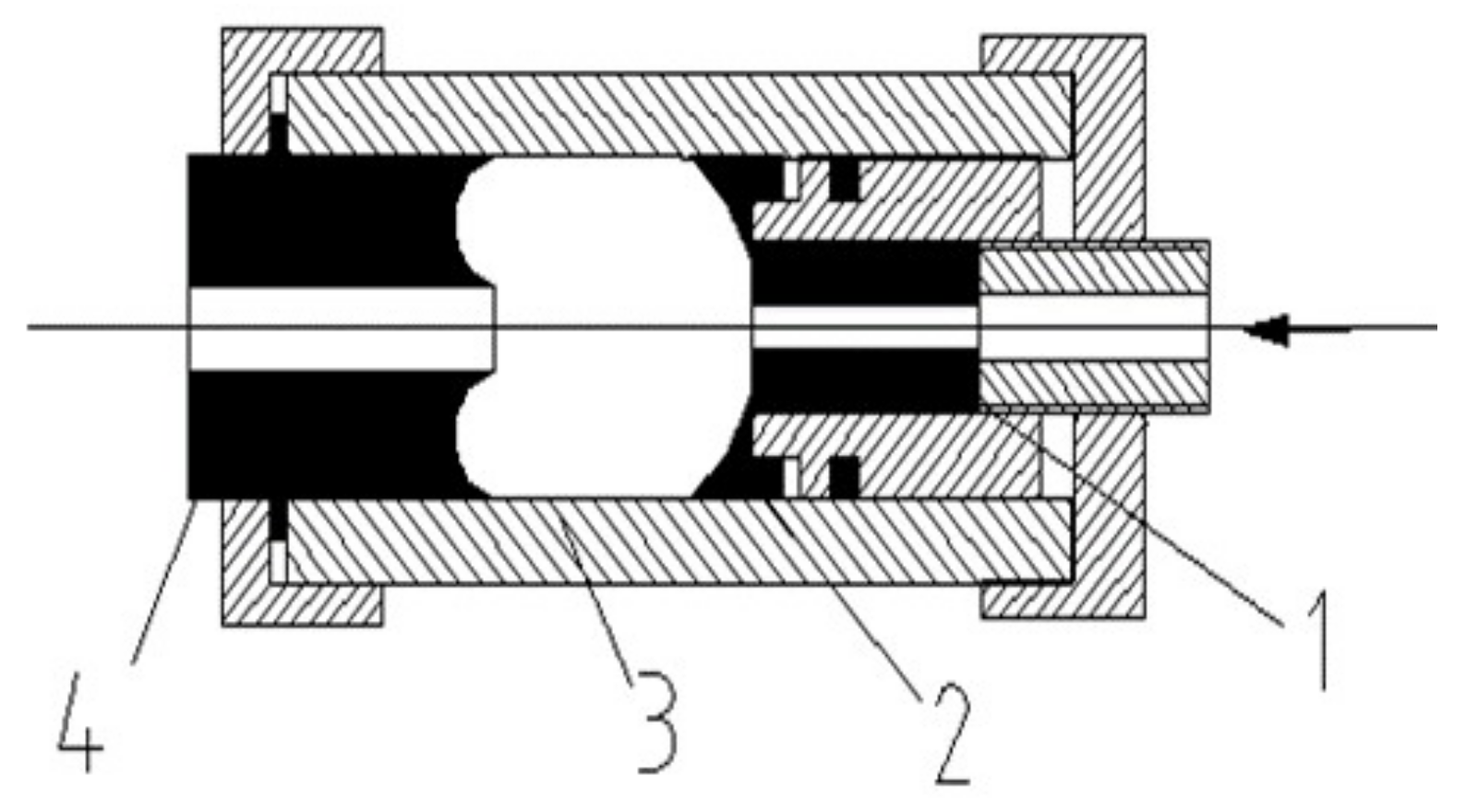


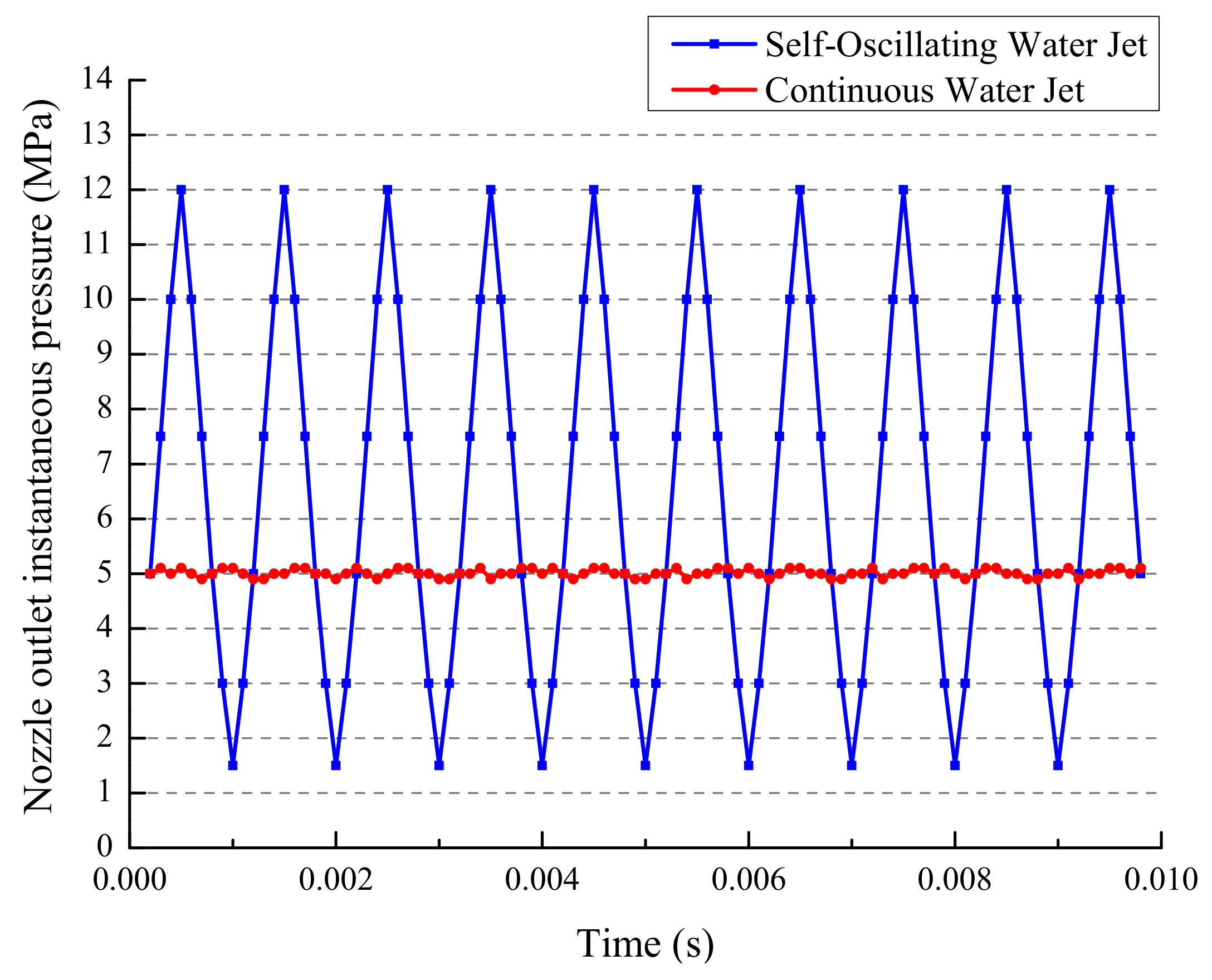
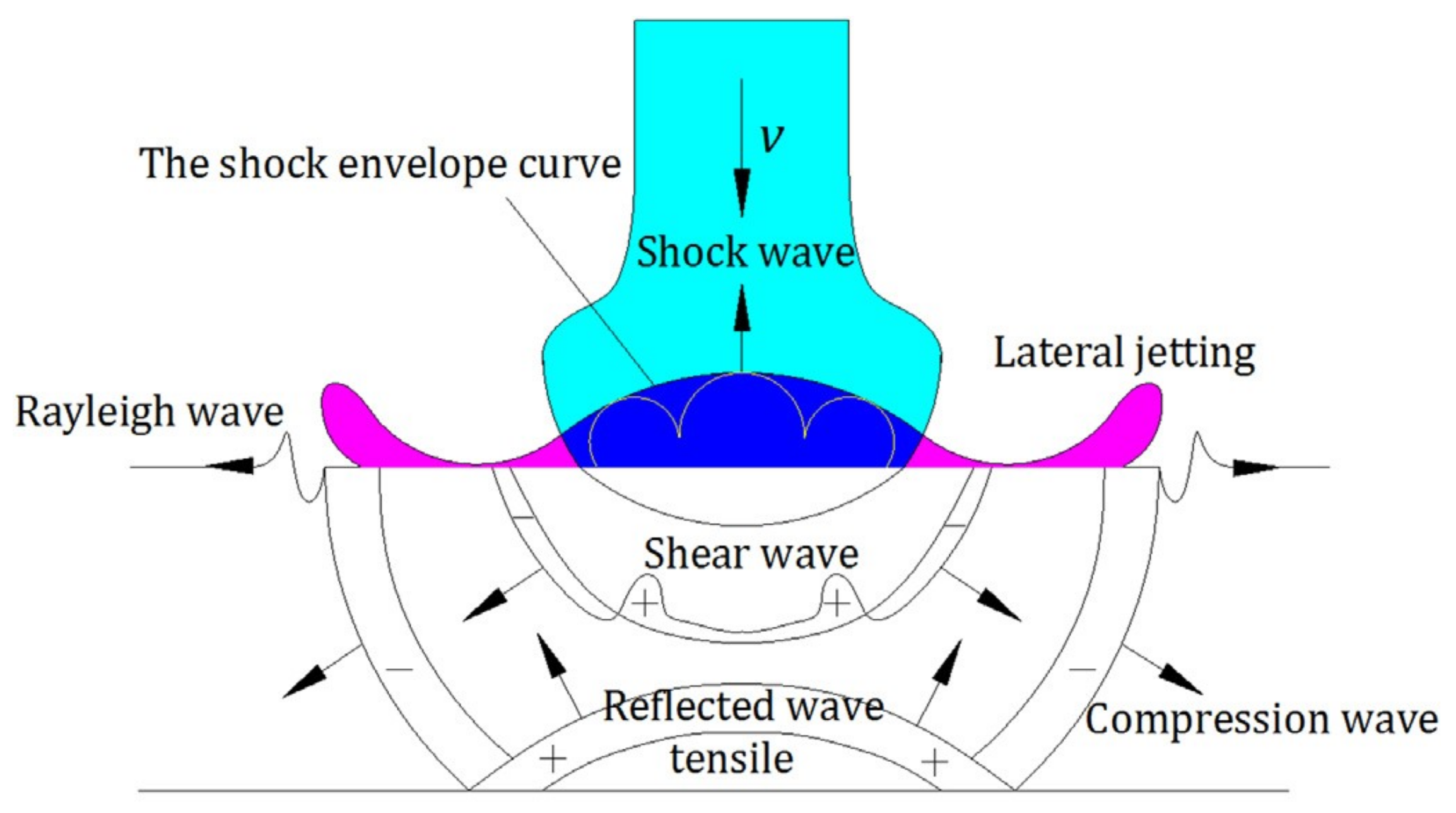



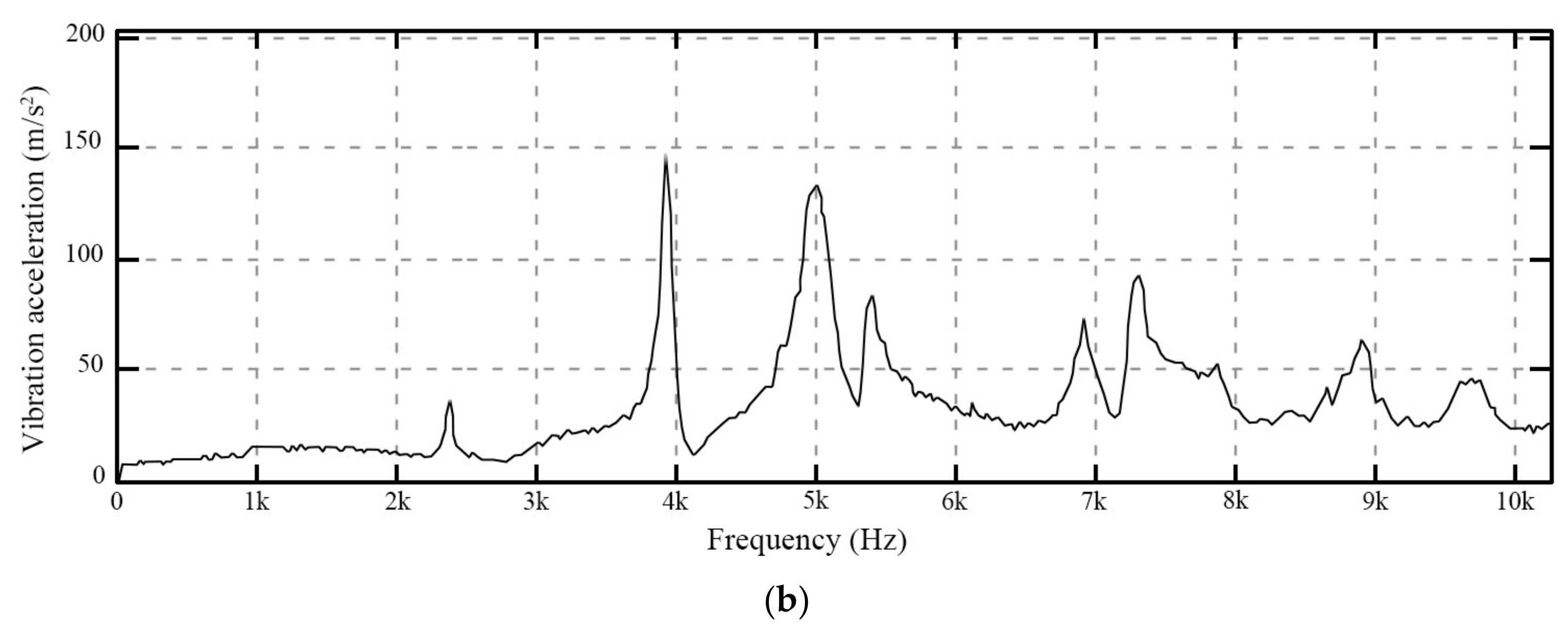

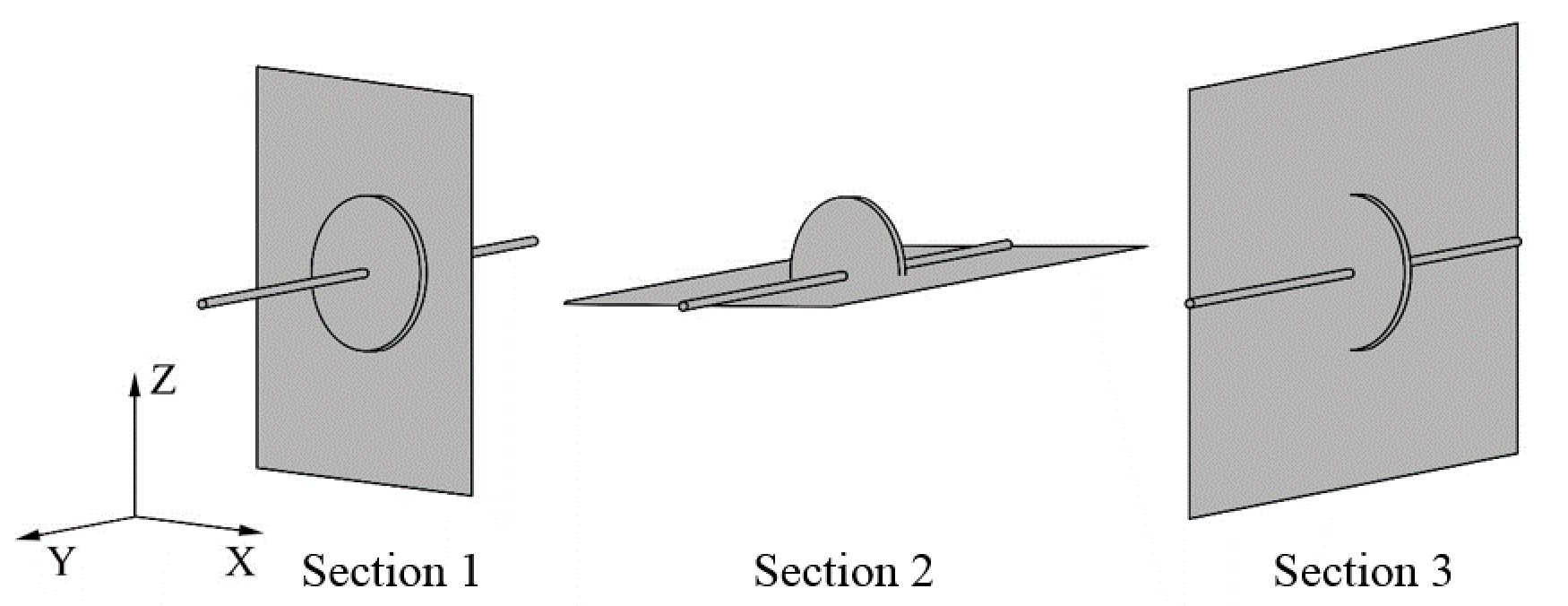
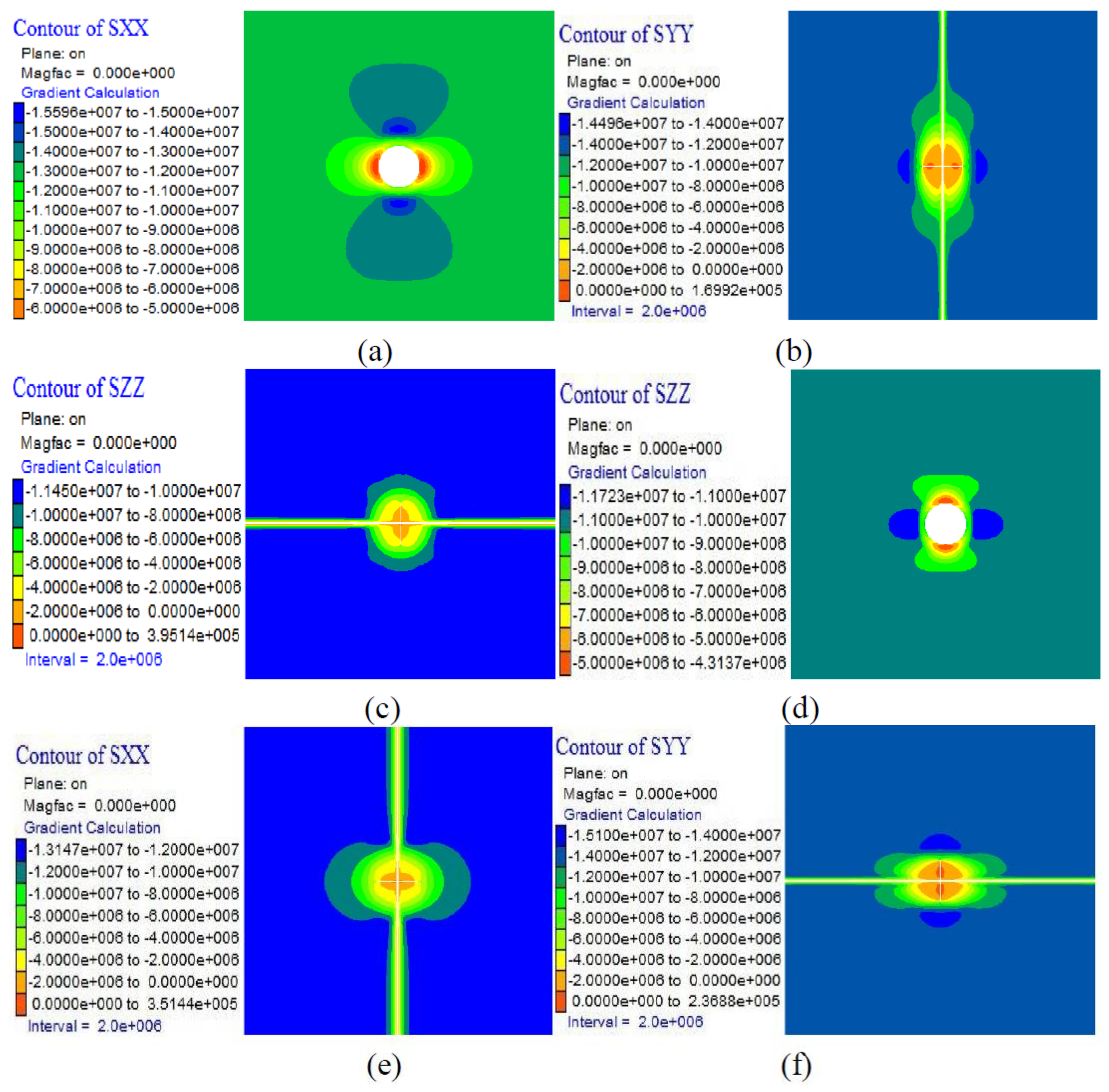



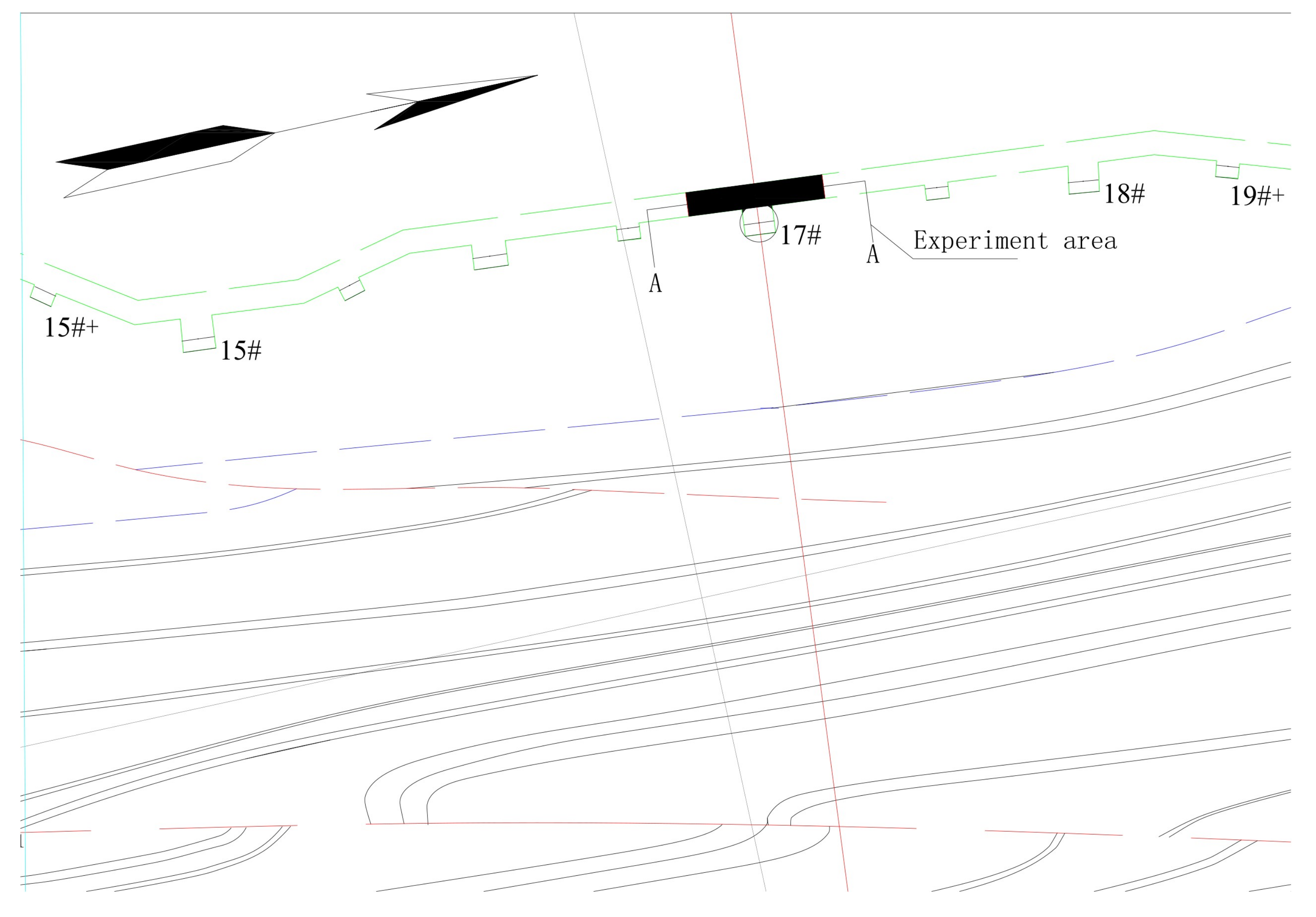

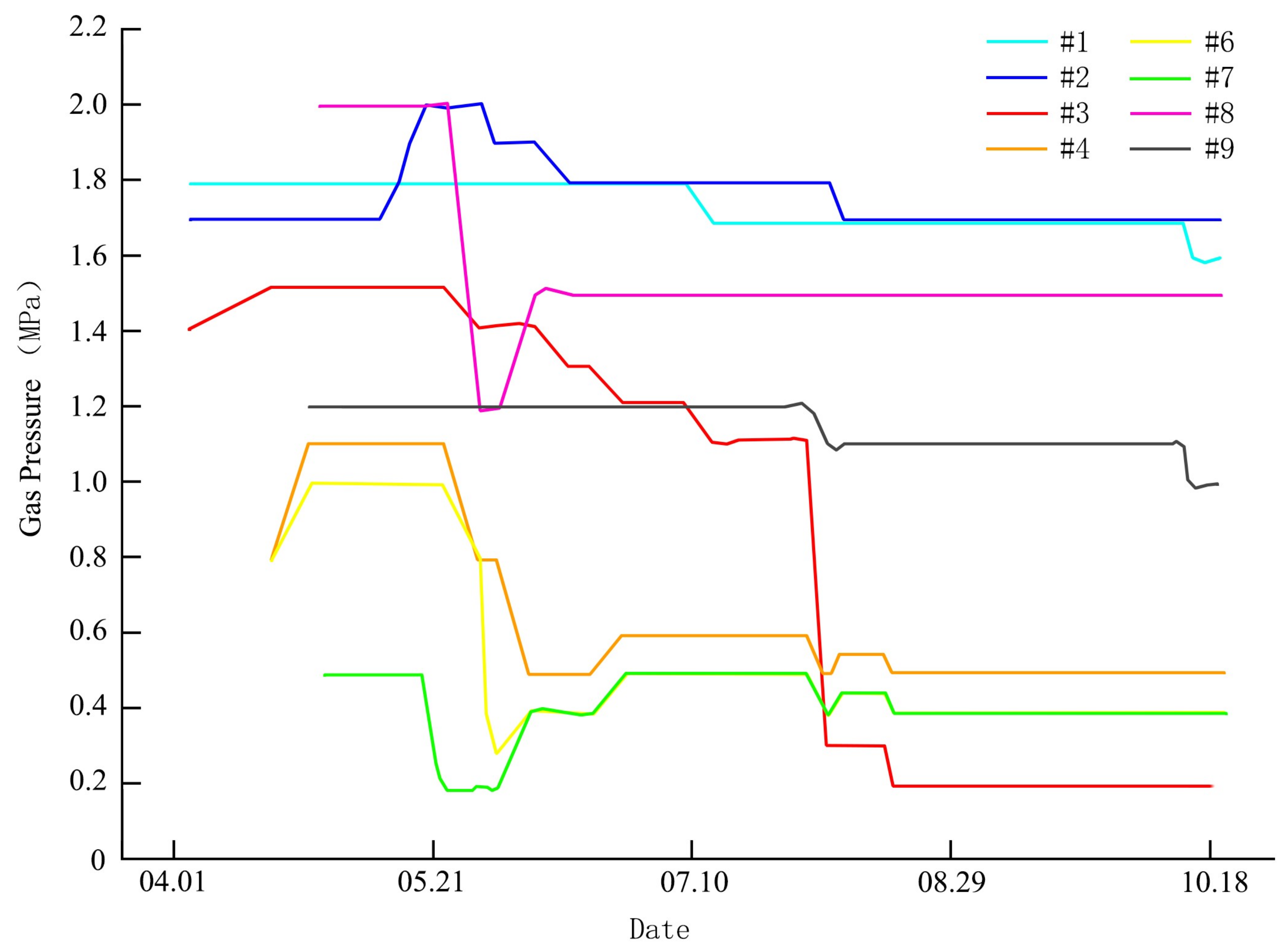
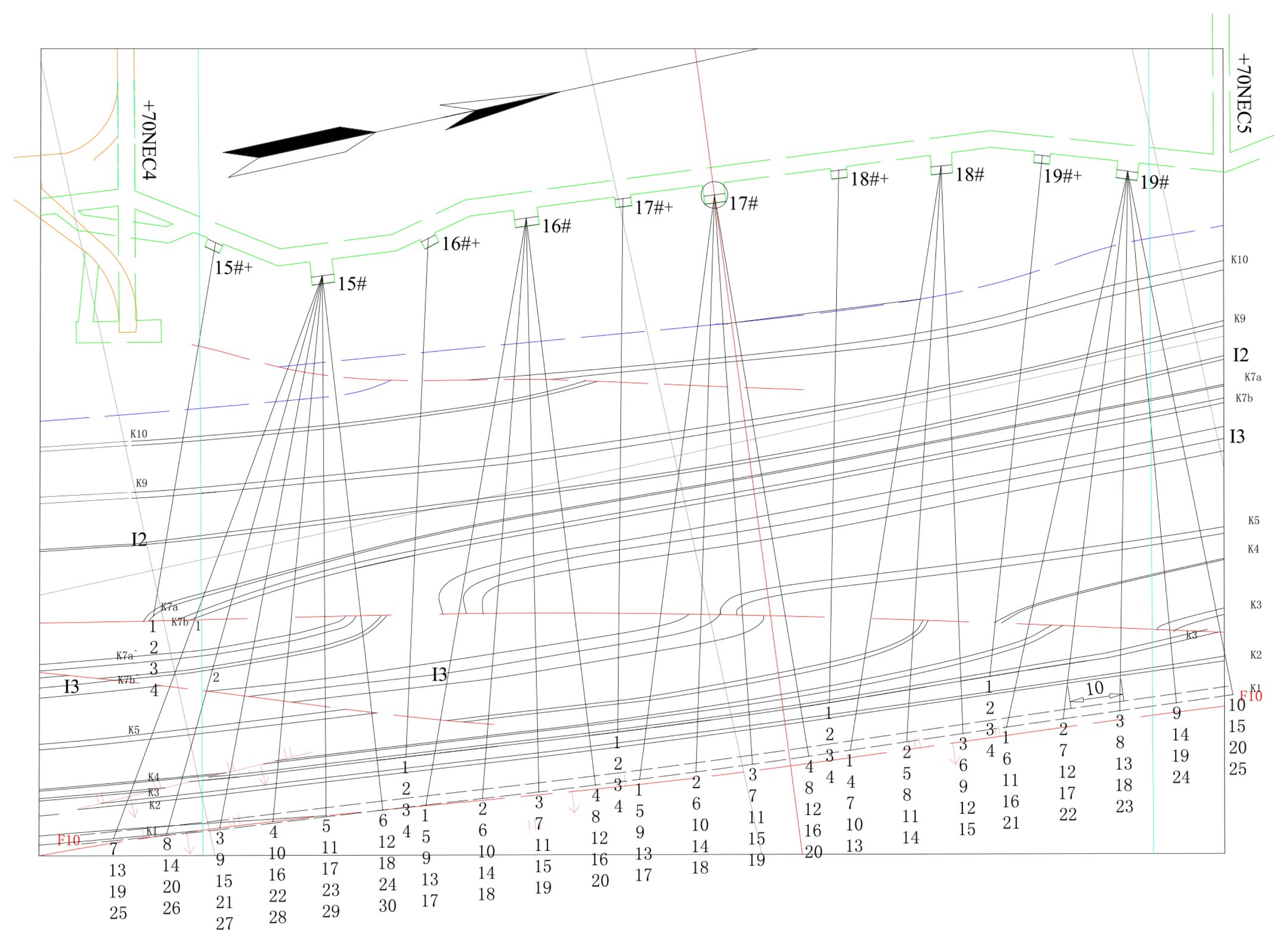

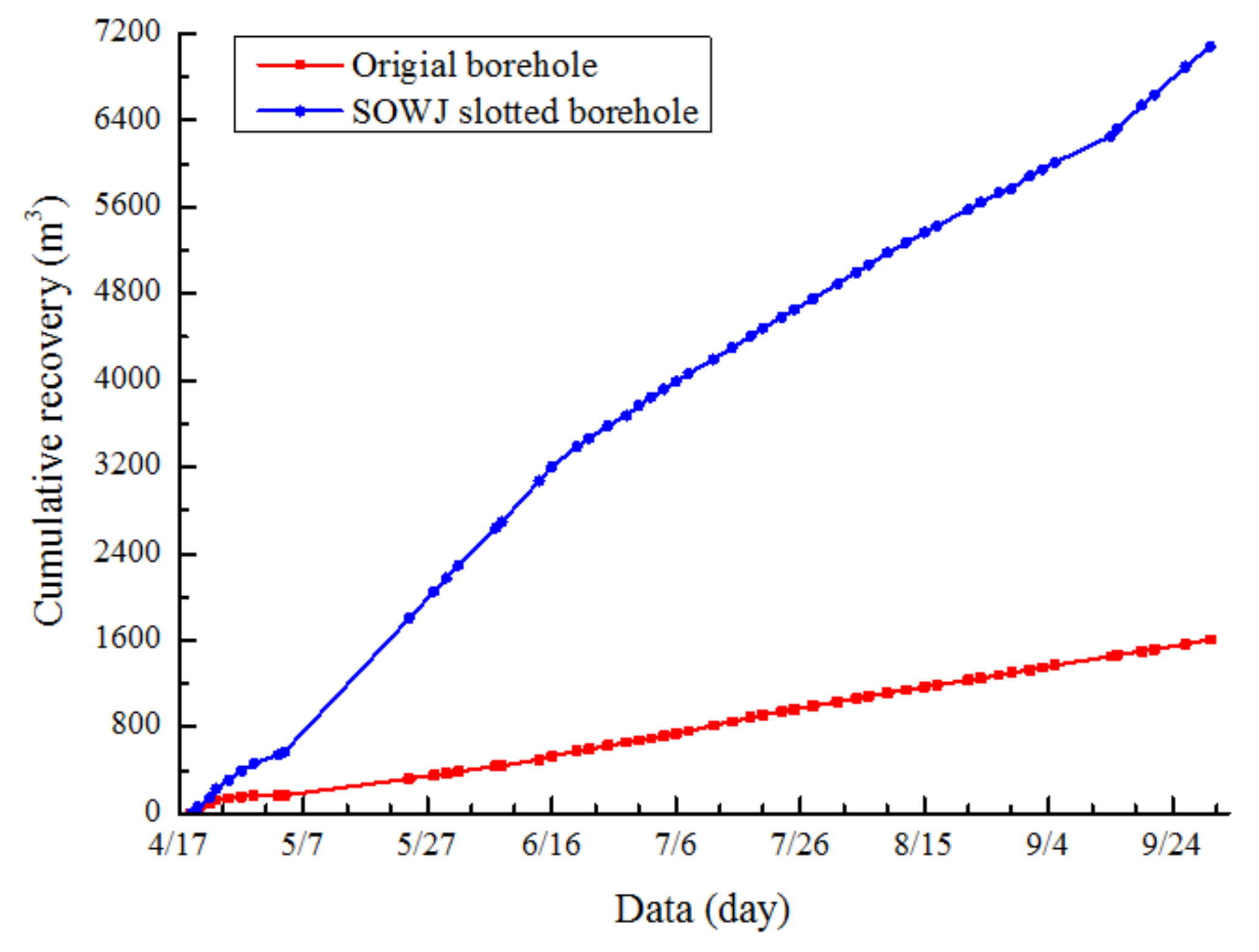
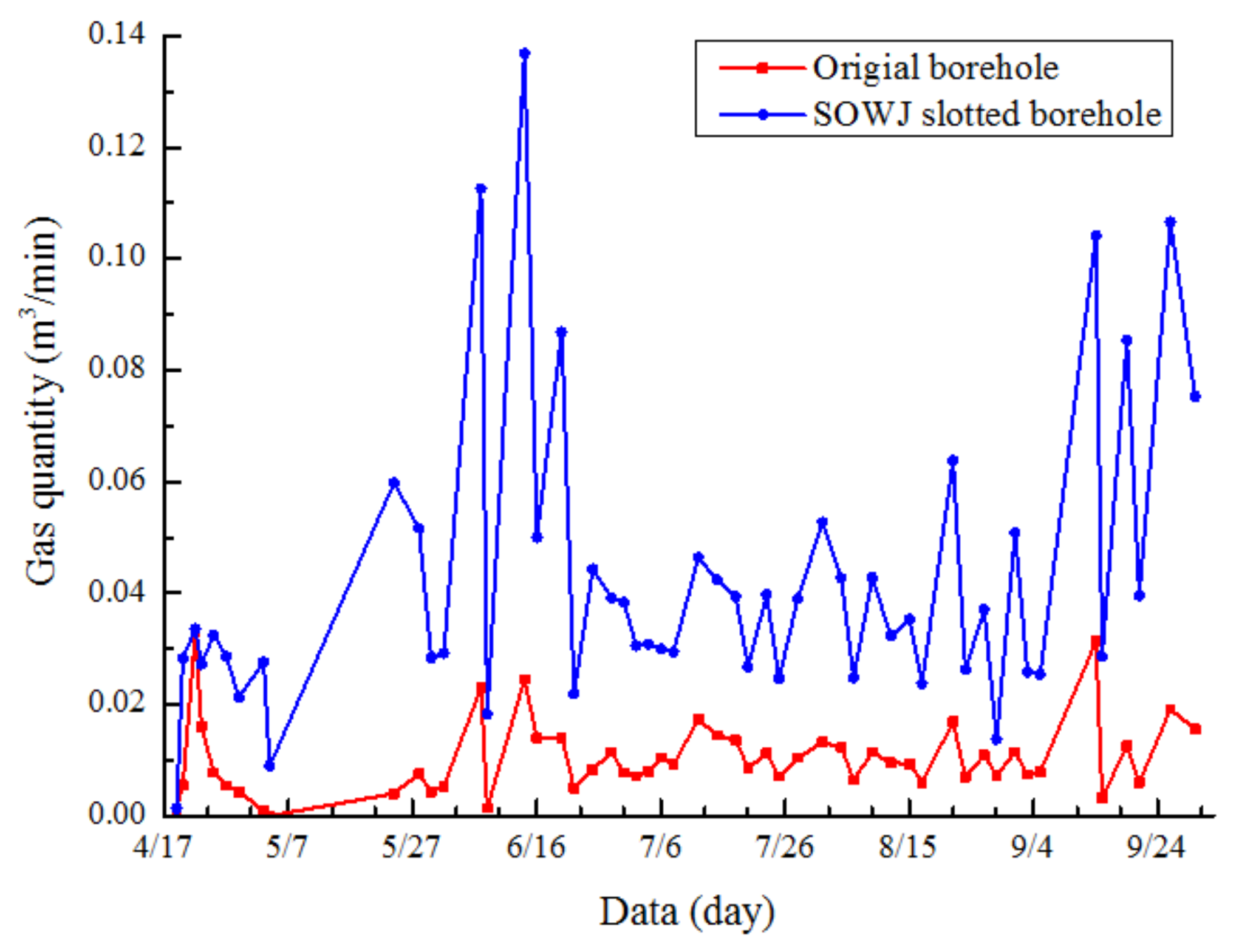
| Bulk Density | Secant Young’s Modulus | Poisson’s Ratio | Acoustic Speed | Brazilian Test Strength | Uniaxial Compressive Strength |
|---|---|---|---|---|---|
| kg m−3 | GPa | m/s | MPa | MPa | |
| 2382 | 54.3 | 0.25 | 4316 | 5.55 | 68 |
| Density (kg/m3) | Bulk Modulus (GPa) | Shear Modulus (GPa) | Friction Angle (°) | Cohesion (MPa) | Dilatancy Angle (°) | Tensile Strength (MPa) |
|---|---|---|---|---|---|---|
| 1450 | 1.67 | 1.25 | 18 | 1.07 | 12 | 0.5 |
| Pump Pressure | 5 MPa | 10 MPa | 15 MPa | 20 MPa | 25 MPa | |
|---|---|---|---|---|---|---|
| Confining Pressure | ||||||
| 0.1 MPa | 0.0192 | 0.0095 | 0.0063 | 0.0047 | 0.0038 | |
| 0.2 MPa | 0.0404 | 0.0198 | 0.0131 | 0.0098 | 0.0078 | |
| 0.3 MPa | 0.0626 | 0.0303 | 0.0200 | 0.0149 | 0.0119 | |
| 0.4 MPa | 0.0857 | 0.0411 | 0.0270 | 0.0201 | 0.0160 | |
| 0.5 MPa | 0.1098 | 0.0520 | 0.0341 | 0.0253 | 0.0202 | |
| Experiment Scheme (Cavitation Number) | Test Targets | Time/s | |||||||
|---|---|---|---|---|---|---|---|---|---|
| 10 | 20 | 50 | 100 | 200 | 400 | 600 | When Experiment Ends | ||
| With No Cavitation Sonic Vibration | Desorption Volume/mL | 200 | 263 | 363 | 455 | 534 | 590 | 619 | 665 (1555 s) |
| Desorption Rate/(mL/s) | 14.00 | 5.21 | 2.65 | 1.43 | 0.53 | 0.18 | 0.12 | 0.017 | |
| 0.0192 | Desorption Volume/mL | 217 | 303 | 435 | 533 | 618 | 679 | 708 | 760 (1340 s) |
| Desorption Rate/(mL/s) | 16.06 | 7.56 | 3.11 | 1.39 | 0.53 | 0.19 | 0.13 | 0.046 | |
| 0.0063 | Desorption Volume/mL | 245 | 364 | 523 | 638 | 743 | 839 | 887 | 945 (1220 s) |
| Desorption Rate/(mL/s) | 20.07 | 10.22 | 3.56 | 1.71 | 0.76 | 0.33 | 0.24 | 0.0026 | |
| 0.0038 | Desorption Volume/mL | 230 | 326 | 465 | 572 | 673 | 746 | 798 | 849 (1300 s) |
| Desorption Rate/(mL/s) | 17.84 | 8.25 | 3.31 | 1.61 | 0.67 | 0.32 | 0.24 | 0.014 | |
| 0.1098 | Desorption Volume/mL | 215 | 301 | 432 | 532 | 616 | 677 | 713 | 754 (1360 s) |
| Desorption Rate/(mL/s) | 15.89 | 7.56 | 3.05 | 1.51 | 0.58 | 0.23 | 0.11 | 0.036 | |
| 0.0341 | Desorption Volume/mL | 238 | 360 | 500 | 608 | 710 | 791 | 834 | 885 (1260 s) |
| Desorption Rate/(mL/s) | 19.44 | 10.35 | 2.8 | 1.64 | 0.72 | 0.30 | 0.25 | 0.0063 | |
| 0.0202 | Desorption Volume/mL | 224 | 319 | 459 | 566 | 667 | 748 | 788 | 830 (1280 s) |
| Desorption Rate/(mL/s) | 17.18 | 8.25 | 3.43 | 1.75 | 0.82 | 0.37 | 0.12 | 0.0083 | |
| Number of Drill Hole | Azimuthal Angle | Dip Angle | Length of Drill Hole | Ending Positions | The Distance to #5 SOWJ Drill Hole |
|---|---|---|---|---|---|
| 1 | 102 | 202 | 127 m | Roof of K1 | 9 m |
| 2 | 102 | 202 | 126 m | Roof of K1 | 7 m |
| 3 | 102 | 202 | 126 m | Roof of K1 | 5 m |
| 4 | 102 | 202 | 126 m | Roof of K1 | 3 m |
| 5 | 102 | 202 | 121 m | Roof of K1 | - |
| 6 | 102 | 202 | 87 m | Roof of K1 | 2 m |
| 7 | 102 | 202 | 126 m | Roof of K1 | 4 m |
| 8 | 102 | 202 | 125 m | Roof of K1 | 6 m |
| 9 | 102 | 202 | 123 m | Roof of K1 | 8 m |
© 2018 by the authors. Licensee MDPI, Basel, Switzerland. This article is an open access article distributed under the terms and conditions of the Creative Commons Attribution (CC BY) license (http://creativecommons.org/licenses/by/4.0/).
Share and Cite
Liu, C.; Xia, B.; Lu, Y. Coalbed Methane Extraction Using the Self-Oscillating Water Jet Slotting Method. Energies 2018, 11, 897. https://doi.org/10.3390/en11040897
Liu C, Xia B, Lu Y. Coalbed Methane Extraction Using the Self-Oscillating Water Jet Slotting Method. Energies. 2018; 11(4):897. https://doi.org/10.3390/en11040897
Chicago/Turabian StyleLiu, Chengwei, Binwei Xia, and Yiyu Lu. 2018. "Coalbed Methane Extraction Using the Self-Oscillating Water Jet Slotting Method" Energies 11, no. 4: 897. https://doi.org/10.3390/en11040897




